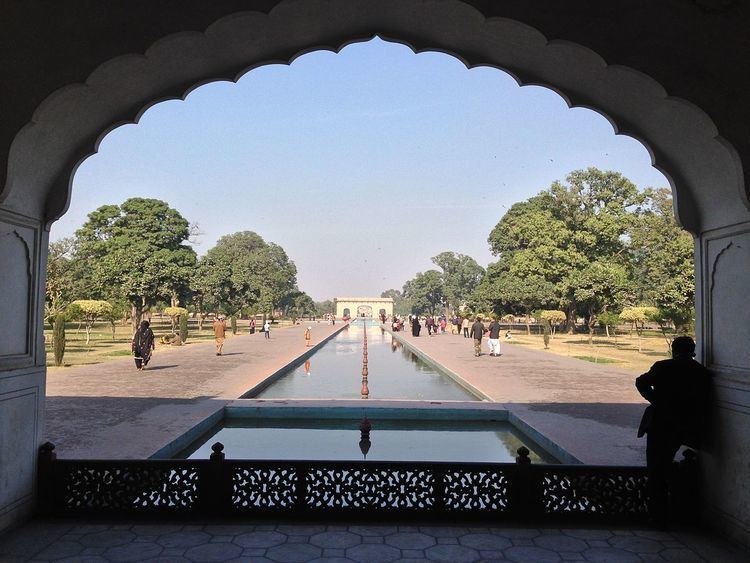Type Cultural Reference 171 Endangered 2000–2012 UNESCO World Heritage Site inscription 30 August 1981 | Criteria i, ii, iii UNESCO region Asia-Pacific Phone +92 310 0040963 | |
 | ||
Address G. T. Road, Lahore 54000, Pakistan Hours Open today · 8AM–6PMFriday8AM–6PMSaturday8AM–6PMSunday8AM–6PMMonday8AM–6PMTuesday8AM–6PMWednesday8AM–6PMThursday8AM–6PMSuggest an edit Similar Lahore Fort, Badshahi Mosque, Tomb of Jahangir, Wazir Khan Mosque, Kamran's Baradari | ||
Shalimar gardens lahore
The Shalimar Gardens (Punjabi, Urdu: شالیمار باغ), sometimes spelled Shalamar Gardens, is a Mughal garden complex located in Lahore, capital of the Pakistani province of Punjab. Construction of the gardens began in 1637 C.E. during the reign of Emperor Shah Jahan, and was completed in 1641.
Contents
- Shalimar gardens lahore
- Location
- Background
- History
- Layout
- Architecture
- Fountains
- Buildings of the Gardens
- Trees of the Gardens
- Conservation
- Gallery
- References
The Shalimar Gardens were laid out as a Persian paradise garden. The gardens measure 658 metres by 258 metres, and cover an area of 16 hectares east of Lahore's Walled City. The gardens are enclosed by a brick wall that is famous for its intricate fretwork.
In 1981 the Shalimar Gardens were inscribed as a UNESCO World Heritage Site as they embody Mughal garden design at the apogee of its development. The gardens date from the period when the Mughal Empire was at its artistic and aesthetic zenith.
Shalimar gardens lahore
Location
The Shalimar Gardens are located near Baghbanpura along the Grand Trunk Road some 5 kilometers northeast of the main Lahore city.
Background
Lahore's Shalimar Gardens were influenced by the older Shalimar Gardens in Kashmir that were built by Shah Jahan's father, Emperor Jahangir. Shah Jahan was involved in construction of the gardens in Kashmir. The most correct etymology of Shalimar's name is Arabic or, more precisely, Arabic-Persian. This etymology has been proposed by the Russian scholar Anna Suvorova who derives the garden’s name from the Arabic expression shah al-‘imarat (Master of Buildings). It should be kept in mind that the word ‘imarat’ (building) was historically used for park architecture and gardens in general.
History
The project management was carried out under the superintendence of Khalilullah Khan, a noble of Shah Jahan's court, in cooperation with Ali Mardan Khan and Mulla Alaul Maulk Tuni. The etymology of the word 'Shalimar' is unknown.
The site of the Shalimar Gardens originally belonged to the Arain Mian Family Baghbanpura. The family was also given the royal title of 'Mian' by the Mughal Emperor, for its services to the Empire. Mian Muhammad Yusuf, then the head of the Arain Mian family, gave the site of Ishaq Pura to the Emperor Shah Jahan, after pressure was placed on the family by the royal engineers who wished to build on the site due to its good position and soil. In return, Shah Jahan granted the Arain Mian family governance of the Shalimar Gardens. The Shalimar Gardens remained under the custodianship of this family for more than 350 years.
In 1962, the Shalimar Gardens were nationalised by General Ayub khan because leading Arain Mian family members had opposed his imposition of martial law in Pakistan.
The Mela Chiraghan festival used to take place in the Gardens, until General Ayub khan ordered against it in 1958.
Layout
The gardens have been laid out from south to north in three levels of terraces, with levels spaced by 4–5 metres (13-15 feet) above the other, descending from south to north. The respective names of the three terraces have been listed as follows:
Architecture
Shalimar Gardens draws inspiration from Central Asia, Kashmir, Punjab, Persia and the Delhi Sultanate. The Shalimar Gardens are laid out in the form of an oblong parallelogram, surrounded by a high brick wall, which is famous for its intricate fretwork. This garden was made on the concept of a Persian paradise garden. The gardens measure 658 meters north to south and 258 meters east to west.
Fountains
From this basin, and from the canal, rise 410 fountains, which discharge into wide marble pools.It is a credit to the creativity of Mughal engineers that even today scientists are unable to fully comprehend the water systems and thermal engineering from architectural blueprints. The surrounding area is rendered cooler by the flowing of the fountains, which is a particular relief for visitors during Lahore's blistering summers, with temperature sometimes exceeding 120 °F (49 °C). The distribution of the fountains is as follows:
The Gardens have 5 water cascades including the great marble cascade and Sawan Bhadoon.
Buildings of the Gardens
The buildings of the Gardens include:
Trees of the Gardens
Some of the varieties of trees that were planted included:
Conservation
In 1981, Shalimar Gardens was included as a UNESCO World Heritage Site along with the Lahore Fort, under the UNESCO Convention concerning the protection of the world's cultural and natural heritage sites in 1972.
